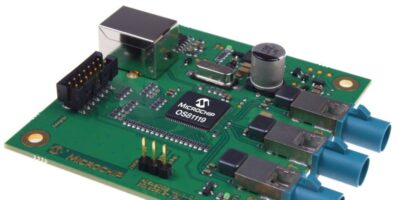MOST network interface controller daisy-chains communications in cars
Microchip has announced the MOST150 intelligent network interface controller (INIC) that reduces automotive wiring and component count, says the company.
The OS81119 INIC enables automotive manufacturers and tier one suppliers to incorporate Media Oriented Systems Transport (MOST) networks in a daisy-chain configuration in addition to a ring topology. With a daisy-chained network, a single cable segment is sufficient to connect two adjacent devices in the network, reducing cables and connectors for the back channel on each network connection. It also eliminates the return wire connecting the last node of the network to the first. This reduces wiring and component count to lower system costs as well as potential weight savings that can impact corporate average fuel economy (CAFE) goals and other fuel efficiency regulations, says Microchip.
The OS81119 INIC allows customers to simplify the network architecture of automotive in-vehicle infotainment systems by using integrated coaxial physical layer (cPHY), optical physical layer (oPHY), daisy-chain topologies or hybrid combinations. Microchip points out that customers currently using MOST150 systems can also rapidly migrate to new topologies or daisy-chain additional nodes with little hardware and software redesign.
The OS81119 INIC is claimed to offer the creation of a MOST150 network using a daisy-chain configuration. Microchip’s Dan Termer, vice president of the Automotive Information Systems business unit says: “MOST networks are a proven standard used in more than 200 car models across all major original equipment manufacturers (OEMs),” He adds that innovation, such as the OS81119, now makes MOST technology even more cost-effective. Besides an integrated cPHY, a USB 2.0 high-speed user interface is also part of the OS81119 INIC. This integration further reduces system component count, to drive down costs. Time to market can be decreased, says Microchip, when using the USB standard and corresponding standardised MOST Linux Drivers.
Additionally, using an open-source Linux operating system (OS) and drivers for the OS81119 helps customers reduce costs. By using the standard application programming interfaces (APIs), customers can also minimise the risk of application issues, says Microchip.
MOST technology is used by many automobile manufacturers and tier one suppliers for in-vehicle networking. It specifically targets infotainment and telematics applications such as smart antennae, head units, amplifiers, digital clusters, rear seat entertainment, advanced driver assistance systems (ADAS), driver/passenger information systems and public transportation infotainment and information systems.
Microchip supports the OS81119 with tools and software, including MOST NetServices V3.2.x, MOST Linux drivers, Microchip’s Unified Centralized Network Stack (UNICENS),
K2L OS81119 USB application board, K2L MOST150 Slim Board family, K2L OptoLyzer MOCCA compact 150c and 150o, K2L INIC Explorer and Microchip Automotive Target Manager (MATM) with OS81119 configuration files and software, K2L MediaLB bus analyser.




